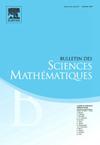Convergence of sub-series' and sub-signed series' in terms of the asymptotic ψ-density
IF 1.3
3区 数学
Q2 MATHEMATICS, APPLIED
引用次数: 0
Abstract
Given a non-negative real sequence such that the series diverges, it is known that the size of an infinite subset can be measured in terms of the linear density such that the sub-series either (a) converges or (b) still diverges. The purpose of this research is to study these convergence/divergence questions by measuring the size of the set in a more precise way in terms of the recently introduced asymptotic ψ-density. The convergence of the associated sub-signed series is also discussed, where is a real sequence with values restricted to the set .
关于渐近ψ密度的子级数和子符号级数的收敛性
给定一个非负实数序列{cn}n,使得级数∑n=1∞cn发散,则已知无限子集a∧n的大小可以用线性密度来度量,使得子序列∑n∈Acn要么(a)收敛,要么(b)发散。本研究的目的是通过用最近引入的渐近ψ密度以更精确的方式测量集合A∧N的大小来研究这些收敛/散度问题。讨论了相关子符号级数∑n=1∞mncn的收敛性,其中{mn}n是一个实数列,其值限制于集合{−1,0,1}。
本文章由计算机程序翻译,如有差异,请以英文原文为准。
求助全文
约1分钟内获得全文
求助全文
来源期刊
CiteScore
1.90
自引率
7.70%
发文量
71
审稿时长
6-12 weeks
期刊介绍:
Founded in 1870, by Gaston Darboux, the Bulletin publishes original articles covering all branches of pure mathematics.

 求助内容:
求助内容: 应助结果提醒方式:
应助结果提醒方式:


